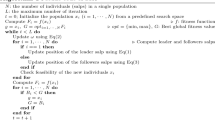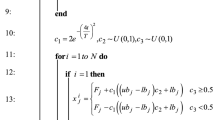Abstract
The most essential task of any algorithm is to maintain the balance between its exploration and exploitation capabilities while solving an optimization problem. Salp Swarm Algorithm (SSA) is a population-based metaheuristic algorithm inspired by the swarming behavior of salps when foraging and navigating in oceans. SSA suffers from stagnation in local optima and poor convergence speed with low solution accuracy. This study proposes a modified SSA based on the Laplace crossover operator called Laplacian Salp Swarm Algorithm (LX-SSA). In LX-SSA, a new position updating mechanism is used by the follower salps to enhance the exploration and solution accuracy of the classical SSA. Thus, better exploration enhances the convergence speed of LX-SSA while avoiding the local optima. The performance of the proposed LX-SSA is tested on a problem set of 23 standard benchmark functions and is compared with the classical SSA along with Ant Lion Optimizer, Moth-flame Optimizer, Sine–Cosine Algorithm, and Whale Optimization Algorithm. The experimental results demonstrate that the proposed LX-SSA outperforms the classical SSA and the other considered algorithms for most of the unimodal and multimodal functions regarding convergence speed and solution precision. A non-parametric Wilcoxon rank sum statistical test has been performed to analyse the results. The experimental and statistical results conclude that the proposed LX-SSA is a promising modified version of classical SSA in terms of convergence and solution accuracy. This paper also examines some computationally expensive and challenging classical engineering design problems.







Similar content being viewed by others
References
Abusnaina AA, Ahmad S, Jarrar R, Mafarja M (2018) Training neural networks using Salp Swarm Algorithm for pattern classification. In: Proceedings of the 2nd international conference on future networks and distributed systems. https://doi.org/10.1145/3231053.3231070
Aljarah I, Mafarja M, Heidari AA (2018) Asynchronous accelerating multi-leader salp chains for feature selection. Appl Soft Comput J 71:964–979
Allah R, Hassanien AE, Elhoseny M, Gunasekaran M (2018) A new Binary Salp Swarm Algorithm: development and application for optimization tasks. Neural Comput Appl 31:1–23
Bakrawy LME (2020) An adaptive optimization algorithm based on modified whale optimization algorithm and Laplace crossover. Int J Metaheuris 7(3):284–305
Bansal JC, Deep K, Veeramachaneni K, Osadciw L (2009) Information sharing strategy among particles in Particle Swarm Optimization using Laplacian operator. In: 2009 IEEE swarm intelligence symposium, pp 30–36. https://doi.org/10.1109/SIS.2009.4937841
Barik AK, Das DC (2018) Active power management of isolated renewable microgrid generating power from rooftop solar arrays, sewage waters and solid urban wastes of a smart city using Salp Swarm Algorithm. In: 2018 Technologies for smart-city energy security and power (ICSESP). IEEE, New York, pp 1–6
Bergh FVD, Engelbrecht AP (2004) A cooperative approach to particle swarm optimization. IEEE Trans Evol Comput 8(3):225–239
Das S, Suganthan PN (2011) Problem definitions and evaluation criteria for CEC 2011 competition on testing evolutionary algorithms on real world optimization problems. Electronics 66:1–42
Deb K, Goyal M (1996) A combined genetic adaptive search (GeneAS) for engineering design. Comput Sci Inform 26:30–45
Deep K, Thakur M (2007) A new crossover operator for real coded genetic algorithms. Appl Math Comput 188:895–911
Dinkar SK, Deep K (2017) Opposition based Laplacian ant lion optimizer. J Comput Sci 23:71–90
Eberhart R, Kennedy J (1995) A new optimizer using particle swarm theory. In: Proceedings of sixth international symposium on micro machine and human science, pp 39–43
Ewees AA, Al-qaness MAA, Elaziz MA (2021) Enhanced salp swarm algorithm based on firefly algorithm for unrelated parallel machine scheduling with setup times. Appl Math Model 94:285–305
Garg V, Deep K (2016) Performance of Laplacian biogeography based optimization algorithm on CEC 2014 continuous optimization benchmarks and camera calibration problem. Swarm Evol Comput 27:132–144
Hegazy AE, Makhlouf MA, El-Tawel GS (2020) Improved salp swarm algorithm for feature selection. J King Saud Univ Comput Inf Sci 32:335–344
Holland JH (1992) Genetic algorithm. Sci Am 267:66–72
Ibrahim A, Ahmed A, Hussein S, Hassanien AE (2018a) Fish image segmentation using Salp Swarm Algorithm. In: International conference on advanced machine learning technologies and applications, Berlin, pp 42–51
Ibrahim RA, Ewees AA, Oliva D, Elaziz MA, Lu S (2018b) Improved Salp Swarm Algorithm based on Particle Swarm Optimization for feature selection. J Ambient Intell Humaniz Comput 10(3):1–15
Kannan BK, Kramer SN (1994) an augmented Lagrange multiplier-based method for mixed integer discrete continuous optimization and its applications to mechanical design. J Mech Des 116:405–411
Karaboga D, Basturk B (2007) A powerful and efficient algorithm for numerical function optimization: Artificial Bee Colony (ABC) algorithm. J Glob Optim 39:459–471
Laplace Distribution (2008) In: The concise encyclopedia of statistics. Springer, New York
Liang JJ, Qin AK, Suganthan PN, Baskar S (2006) Comprehensive learning particle swarm optimizer for global optimization of multimodal functions. IEEE Trans Evol Comput 10(3):281–295
Meraihi Y., Ramdane-Cherif A, Mahseur M, Achelia D (2018) A Chaotic Binary Salp Swarm Algorithm for solving the graph coloring problem. In: International symposium on modelling and implementation of complex systems, pp 106–118
Mirjalili S (2015a) Ant lion optimizer. Adv Eng Softw 83:80–98
Mirjalili S (2015b) Moth-flame optimization algorithm: a novel nature-inspired heuristic paradigm. Knowl-Based Syst 89:228–249
Mirjalili S (2016) SCA: a Sine Cosine Algorithm for solving optimization problems. Knowl Based Syst 96:120–133
Mirjalili S, Lewis A (2016) The whale optimization algorithm. Adv Eng Softw 95:51–67
Mirjalili S, Mirjalili SM, Lewis A (2014) Grey wolf optimizer. Adv Eng Softw 69:46–61
Mirjalili S, Gandomi AH, Mirjalili SZ, Saremi S, Faris H, Mirjalili SM (2017) Salp Swarm Algorithm: a bio-inspired optimizer for engineering design problems. Adv Eng Softw 114:163–191
Ren H, Li J, Chen H, Li C (2021) Stability of salp swarm algorithm with random replacement and double adaptive weighting. Appl Math Model 95:285–305
Sayed GI, Khioriba G, Haggag MH (2018) A novel Chaotic SSA for global optimization and feature selection. Appl Intell 48:3462–3481
Sharma TK, Pant M, Singh VP (2012) Improved local search in Artificial Bee Colony using golden section search, arXiv:1210.6128
Si T, Miranda PBC, Bhattacharya D (2022) Novel enhanced Salp Swarm Algorithms using opposition-based learning schemes for global optimization problems. Expert Syst Appl 66:207
Singh A, Deep K (2015) Real coded genetic algorithm operator embedded in Gravitational Search algorithm for continuous optimization. Int J Intell Syst Appl 12:1–22
Singh N, Son LH, Chiclana F, Magnot JP (2019) A new fusion of Salp Swarm with Sine-Cosine for optimization of non-linear functions. Eng Comput 66:1–28
Wan Y, Mao M, Zhou L (2019) A novel nature-inspired maximum power point tracking (MPPT) controller based on SSA-GWO algorithm for partially shaded photovoltaic systems. Electronics 8:680. https://doi.org/10.3390/electronics8060680
Wang D, Zhou Y, Jiang S, Liu X (2018) A Simplex method based Salp Swarm Algorithm for numerical and engineering optimization. In: International conference on intelligent information processing, pp 150–159
Wolpert DH, Macready WG (1997) No free lunch theorems for optimization. IEEE Trans Evol Comput 1:67–82
Yang XS (2020) Nature-inspired optimization Algorithms. Academic Press
Yu H, Qiao S, Heidari AA, Saleh AA, Bi C, Mafarja M, Cai Z, Chan H (2022) Laplace crossover and random replacement strategy boosted Harris Hawk optimization: performance optimization and analysis. J Comput Des Eng 6:66
Zhang J, Wang JS (2020) Improved salp swarm algorithm based on levy flight and sine cosine operator. IEEE Access 8:99740–99771
Zhang X, Wang S, Zhao K, Wang Y (2023) A salp swarm algorithm based on Harris Eagle foraging strategy. Math Comput Simul 203:858–877
Zhao X, Yang F, Han Y, Cui Y (2020) An opposition-based learning chaotic Salp Swarm Algorithm for global optimization. IEEE, pp 36485–36501
Funding
This research is funded by Ministry of Education, India.
Author information
Authors and Affiliations
Corresponding author
Ethics declarations
Conflict of interest
The authors declare that they have no conflicts of interest.
Ethical approval
All the authors abide by the ethical rules of the journal.
Informed consent
Informed consent was obtained from all individual participants included in the study.
Additional information
Publisher's Note
Springer Nature remains neutral with regard to jurisdictional claims in published maps and institutional affiliations.
Rights and permissions
Springer Nature or its licensor (e.g. a society or other partner) holds exclusive rights to this article under a publishing agreement with the author(s) or other rightsholder(s); author self-archiving of the accepted manuscript version of this article is solely governed by the terms of such publishing agreement and applicable law.
About this article
Cite this article
Solanki, P., Deep, K. Laplacian Salp Swarm Algorithm for continuous optimization. Int J Syst Assur Eng Manag (2023). https://doi.org/10.1007/s13198-023-01935-y
Received:
Revised:
Accepted:
Published:
DOI: https://doi.org/10.1007/s13198-023-01935-y




